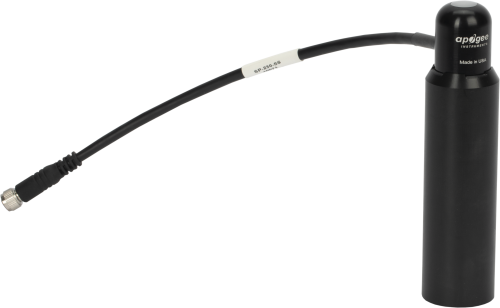
Heater prevents snow, frost, and dew accumulation






Overview
The SP230SS pyranometer, manufactured by Apogee, includes a 0.18 W internal heater and an elevated base that allow it to provide solar radiation measurements during the most severe weather. Its small heater draws just 15 mA of current, allowing it to be powered by a small solar panel and battery─even on days with a short duration of daylight and at high latitudes (far away from the equator).
This pyranometer features an IP67-rated, marine-grade 316L connector that allows the user to easily swap sensors for recalibration or to replace damaged cables.
Read MoreBenefits and Features
- Designed to prevent snow, frost, and dew accumulation
- Heater uses 1/80th of the power that other heated pyranometers use, making it ideal for remote battery-powered applications
- Measurement waveband of 360 to 1120 nm
- Compatible with most Campbell Scientific data loggers
- Dome-shaped head prevents water from accumulating on the sensor head
Images

Detailed Description
The SP230SS uses a silicon photovoltaic detector mounted in a cosine-corrected head to provide solar radiation measurements. It is calibrated against a Kipp & Zonen CM21 thermopile pyranometer to accurately measure sun plus sky radiation for the spectral range of 360 to 1120 nm. The SP230SS outputs a millivolt signal that Campbell Scientific data loggers can measure.
Note: Sensors calibrated to the 360 to 1120 nm spectral range should not be used under vegetation or artificial lights.
Similar Products
Compatibility
Mounting
Accurate measurements require the sensor to be leveled using a 18356 leveling fixture. This leveling fixture incorporates a bubble level and three adjusting screws. The 18356 mounts to a crossarm using the CM225 mounting stand. The SP230SS should be mounted away from all obstructions and reflective surfaces that might adversely affect the measurement.
Specifications
| Sensor | Silicon photovoltaic detector mounted in a cosine-corrected head |
| Measurement Description | Measures sun plus sky radiation |
| ISO Classification | Class C (second class) |
| Spectral Range | 360 to 1120 nm (wavelengths where response is 10% of maximum) |
| Measurement Range | 0 to 1750 W/m2 (full sunlight ≈1000 W/m2) |
| Heater | 780 Ω, 15.4 mA current drain, 185 mW power at 12 Vdc |
| Absolute Accuracy | ±5% for daily total radiation |
| Sensitivity | 0.2 mV/W/m2 |
| Calibration Factor | 5 W/m2/mV |
| Cosine Response | ±5% at 75° zenith angle; ±1% at 45° zenith angle |
| Temperature Response | -0.04 ±0.04% per °C |
| Long-Term Stability | < 2% per year |
| Operating Temperature Range | -40° to +70°C |
| Relative Humidity Range | 0 to 100% |
| Compliance with Standards |
|
| Diameter | 3.15 cm (1.24 in.) |
| Height | 12.75 cm (5.02 in.) |
| Weight | 142.0 g (5.01 oz) with 2 m (6.56 ft) cable |
Related Documents
Product Brochures
Compliance
FAQs for
Number of FAQs related to SP230SS: 2
-
No. The SP230SSCBL is used with the SP230SS.
-
For thermopile pyranometers, a thermopile is used within the instrument as the sensor, and the thermal gradients are measured across hot and cold areas (black and white). The radiation intensity is proportional to the temperature differences between the two sensing areas. Accuracy depends upon the sensitivity of the material used in the sensors, the response time, and the distortion characteristics of the material constituting the dome (if present) covering the sensors.
For silicon photocell pyranometers, electric current is generated by a photo-sensitive diode in proportion to solar intensity. Ordinarily, silicon photocell pyranometers are not fully sensitive to the full spectrum of visible light, and they cannot “see” a certain portion of the electromagnetic spectrum such as under cloudy conditions or vegetative canopies. Silicon photocell pyranometers will introduce errors under these conditions. In full sunlight conditions, however, they are calibrated to properly output solar radiation measurements.

